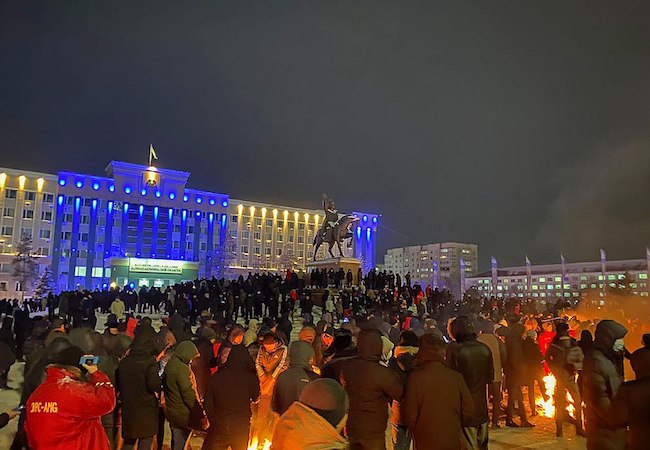
By Kateryna Odarchenko
Early 2022 got marked with the massive protests in Kazakhstan, which have already led to the burning of the city hall of Alma-Ata and the general chaos of a large part of the country, except the capital of Nursultan (formerly Astana) and the northern part of the country, inhabited mainly by ethnic Russian citizens of Kazakhstan. The leading cause of the unrest is the lack of political competition. Nazarbayev’s clan continues to de facto rule the country, even though Nursultan Nazarbayev formally resigned from his presidency back in 2019. The current President Tokayev has already asked the Collective Security Treaty Organization (CSTO) for help. (The CSTO is de facto the Russian analog of NATO in the territory of the countries of the former Soviet Union).
Russia uses the internal conflict in Kazakhstan as part of its confrontation with the West. Most recently, Russia issued a harsh ultimatum – the United States must promise in writing not to expand NATO to the East, hence to Ukraine not to join NATO. Recently, the US President’s National Security Advisor Jake Sullivan de facto confessed that the US would not discuss such issues with Russia regarding NATO’s accession or non-alignment of sovereign states. Russia will undoubtedly use the destabilization in Kazakhstan and the deployment of troops of the CSTO member states to strengthen its influence in the country further.
Ukraine can use this time to strengthen its defenses. Since the troops of the CSTO countries have already been deployed in Kazakhstan, Russia will focus on returning to the status quo, namely, keeping Nursultan Nazarbayev’s clan in power. De jure, N. Nazarbayev resigned from his presidency back in 2019 and took up the post of a member of the Constitutional Council of Kazakhstan. However, he and his clan de facto govern the country and its essential resources. As of the morning of January 6, 2022, the first military units of the CSTO countries have already crossed the border with Kazakhstan. The current government of Kazakhstan has enlisted the help of Russia and other CSTO member countries to restore order in the country and return the status quo.
Amid the protests in Kazakhstan, the bitcoin value went down, signaling to the whole world that in times of turmoil, the most reliable means of payment and capital accumulation is the US dollar, not cryptocurrency. Therefore, in the current situation in Kazakhstan, there can be many winning sides, such as Russia, which is now directly present in Kazakhstan militarily, and the US Federal Reserve, which is based on trust in the US dollar as the most reliable means of payment and storage of value.
The strengthening of Russia’s influence in Kazakhstan also does not contradict China’s interests in this country. In Kazakhstan, Chinese President Xi Jinping in 2013 announced the creation of the New Silk Road (literal translation from Chinese: “One Belt – One Road”). Although China has minimal use of its armed forces outside its country, China’s foreign policy, among other things, is aimed at ensuring safe and stable routes for goods from China to Europe, where some of the goods are transported by sea and some by land. Kazakhstan plays a vital role in ensuring a stable flow of goods from China to Europe.
In the case of a possible violent seizure of Taiwan, China is likely to fall into a naval blockade, aiming to economically strangulate China by closing the sea routes for transporting goods. Thus, the role of Central Asia in general and Kazakhstan in particular increases multifold in terms of the prosperity of China, which, in turn, critically depends on the stable export of its products to Europe.




